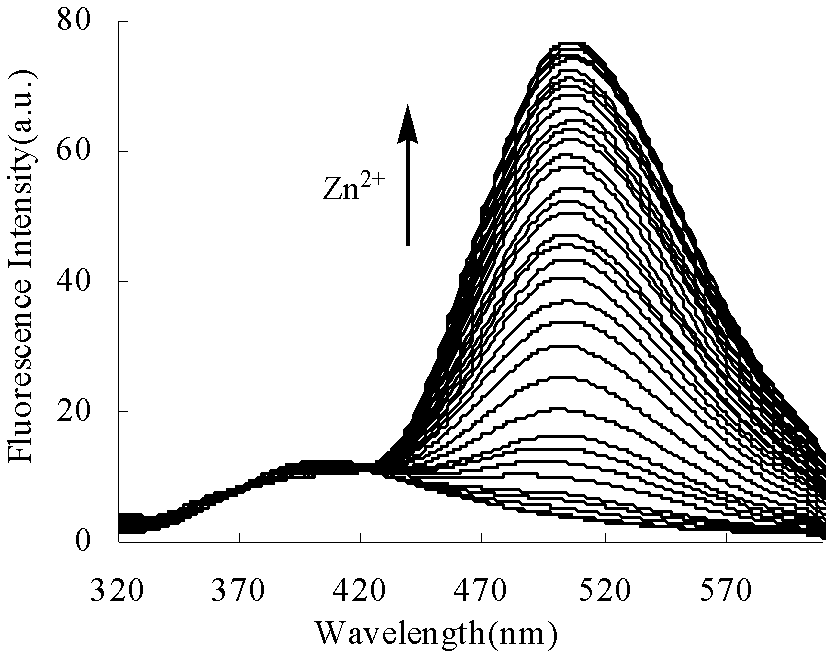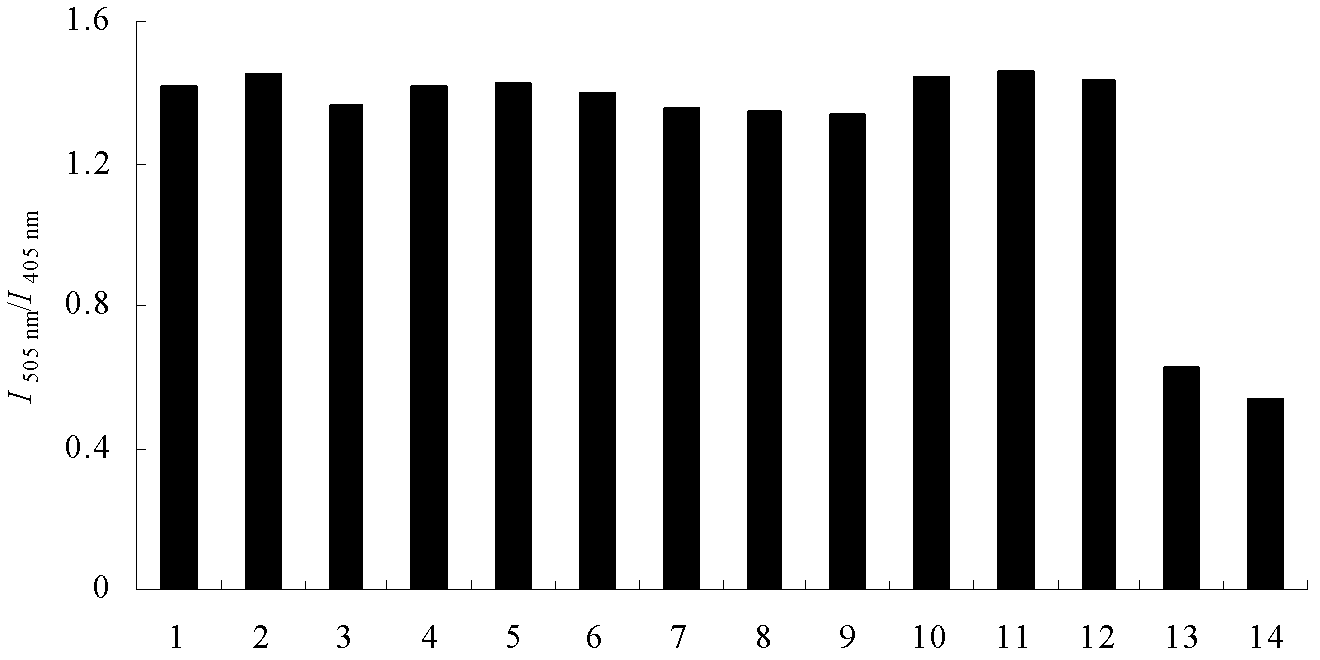Novel method for constructing Zn2+ ratio detecting system by solubilizing fluorescent probe in micelle
A new method, micellar technology, is applied in the field of constructing Zn2+ ratiometric fluorescence detection system to achieve the effect of improving accuracy and reducing complexity
- Summary
- Abstract
- Description
- Claims
- Application Information
AI Technical Summary
Problems solved by technology
Method used
Image
Examples
Embodiment 1
[0018] 8-carboxamidoquinoline derivatives, the structure is shown in the general formula (R 1 = Cl, R 2 =R 3 =H). The concentration of probe molecules is 1.0×10 -5 mol / L SDS (12mmol / L, 10mmol / L Tris-HCl, pH=7.2) solution, add various common metal ions (Na + 、K + , Mg 2+ , Ca 2+ 、Cr 3+ , Fe 3+ 、Co 2+ 、Ni 2+ 、Cu 2+ , Zn 2+ 、Ag + 、Cd 2+ , Hg 2+ , Pb 2+ ), the fluorescence spectrum was measured when the concentration was 5 times of the probe concentration. The maximum emission wavelength of the probe molecule is 405nm when no metal ions are added; Zn 2+ Make the probe molecules appear double fluorescent peaks at 405 and 505nm, and the fluorescent peak at 405nm remains basically unchanged; Ni 2+ 、Cu 2+ The fluorescence of the solution is quenched, while other metal ions have no obvious effect on the fluorescence spectrum of the solution. Where: the ordinate represents the fluorescence intensity, and the abscissa represents the fluorescence wavelength.
Embodiment 2
[0020] 8-carboxamidoquinoline derivatives, the structure is shown in the general formula (R 1 = Cl, R 2 =R 3 =H). The concentration of probe molecules is 1.0×10 -5 mol / L SDS (12mmol / L, 10mmol / L Tris-HCl, pH=7.2) solution, Zn 2+ When the concentration is 0-100 times of the probe concentration, measure its fluorescence spectrum. With Zn 2+ With the addition of , the fluorescence peak intensity of the probe molecules at 405nm remained basically unchanged, but a new fluorescence peak appeared at 505nm, and its intensity gradually increased. Using the fluorescence peak at 405nm as an internal standard, the probe molecule can be used for Zn 2+ ratiometric fluorescence detection. Where: the ordinate represents the fluorescence intensity, and the abscissa represents the fluorescence wavelength.
Embodiment 3
[0022] 8-carboxamidoquinoline derivatives, the structure is shown in the general formula (R 1 = Cl, R 2 =R 3 =H). The concentration of probe molecules is 1.0×10 -5 mol / L SDS (12mmol / L, 10mmol / L Tris-HCl, pH=7.2) solution, add Zn 2+ and other common metal ions (Na + 、K + , Mg 2+ , Ca 2+ 、Cr 3+ , Fe 3+ 、Co 2+ 、Ni 2+ 、Cu 2+ 、Ag + 、Cd 2+ , Hg 2+ , Pb 2+ ), Zn 2+ When it coexists with other metal ions and the concentration is 5 times of the probe concentration, measure its fluorescence spectrum. Most metal ions (Na + 、K + , Mg 2+ , Ca 2+ 、Cr 3+ , Fe 3+ 、Co 2+ 、Ag + 、Cd 2+ , Hg 2+ , Pb 2+) do not interfere with Zn 2+ The fluorescence emission of the complex, the intensity ratio of its double fluorescence peaks and the presence of only Zn in solution 2+ similar when Ni 2+ 、Cu 2+ It binds tightly to the probe molecule and interferes with Zn 2+ detection. Among them: the vertical axis represents the ratio of the double fluorescence peak intensity, the ...
PUM
 Login to View More
Login to View More Abstract
Description
Claims
Application Information
 Login to View More
Login to View More - R&D
- Intellectual Property
- Life Sciences
- Materials
- Tech Scout
- Unparalleled Data Quality
- Higher Quality Content
- 60% Fewer Hallucinations
Browse by: Latest US Patents, China's latest patents, Technical Efficacy Thesaurus, Application Domain, Technology Topic, Popular Technical Reports.
© 2025 PatSnap. All rights reserved.Legal|Privacy policy|Modern Slavery Act Transparency Statement|Sitemap|About US| Contact US: help@patsnap.com



